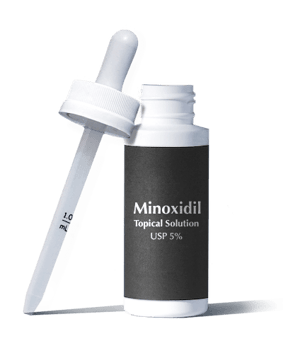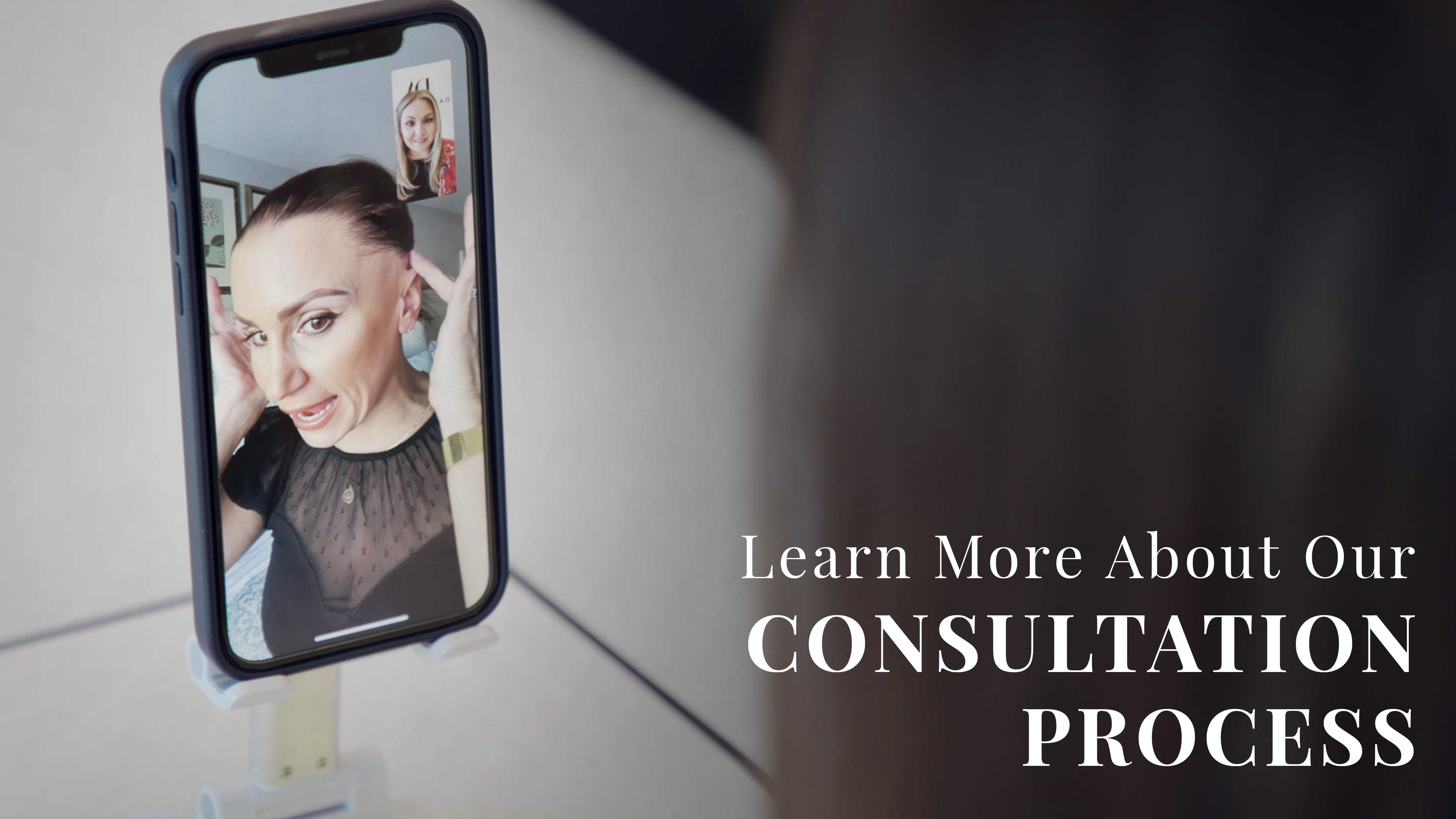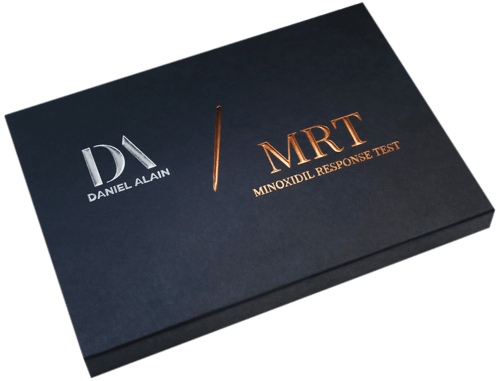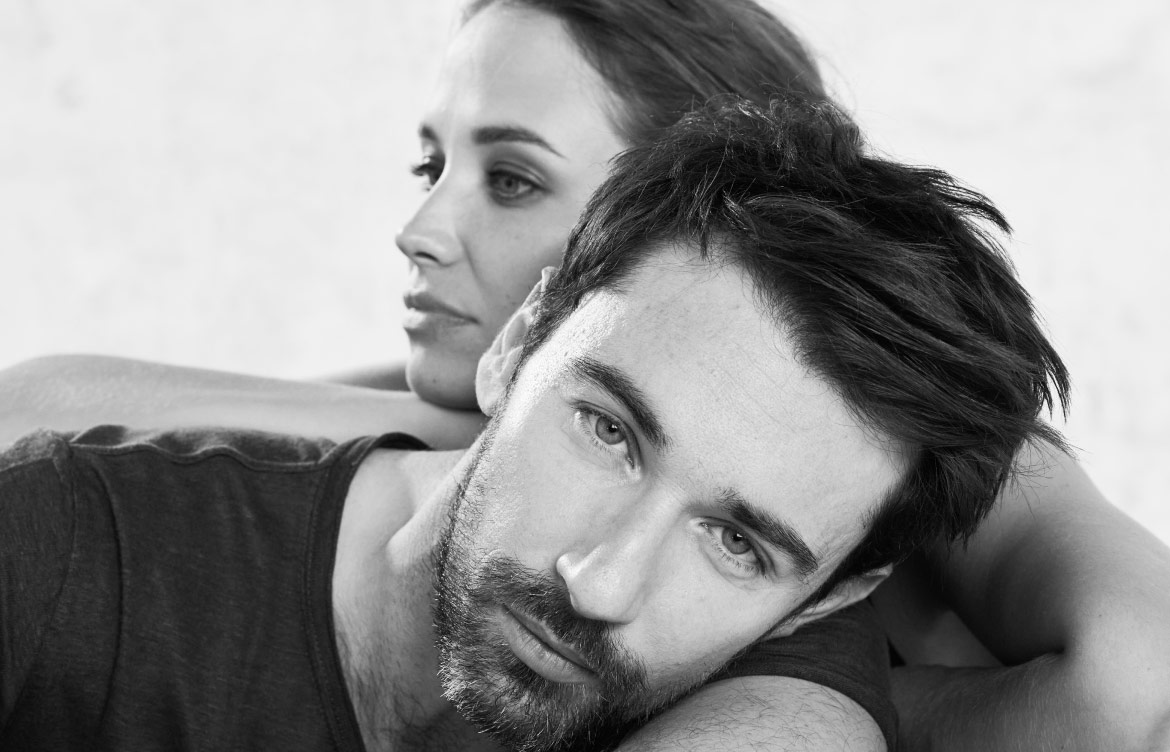Minoxidil is a hair loss treatment trusted by many men and women for hair regrowth. But is it safe to use Minoxidil? In most cases, yes. But like all medications, the drug has some risks for side effects.
Minoxidil is one of two FDA-approved medications for hair loss. You might better recognize it as Rogaine®, the most common brand-name version.
While Minoxidil works for many people, it doesn’t work for everyone. Considering the duration of use, potential side effects, and investment, the best thing to do is to get tested. Our breakthrough Minoxidil Response Test will tell you with 95.9% accuracy if Minoxidil will work for you based on your scalp enzymes.
If you’re considering using Minoxidil, it’s important to weigh the risks. For the most part, Minoxidil is safe. In this article, we’ll share all about Minoxidil safety, side effects, and factors to consider to help you make an informed decision.

IS MINOXIDIL SAFE FOR LONG-TERM USE?

Overall, Minoxidil is safe for long-term use for both men and women. The FDA approved it as an androgenetic alopecia treatment for men in 1988 and women in 1991.
FDA approval means a drug is:
- Safe: The benefits outweigh the risks, and the product meets federal quality standards.
- Effective: The FDA assesses a company’s laboratory and product testing, and conducts their own testing on some biological products.
Of course, not everyone experiences the same results touted by FDA approval — that’s one of the problems with Minoxidil.
Minoxidil is only effective for the amount of time you take it. That could be months, years, or even decades. Stopping treatment might trigger your hair fall again, but how safe is Minoxidil to warrant indefinite use?
Many dermatologists agree that Minoxidil is safe for long-term use, with one MD recommending consistent use to maintain regrowth. Another dermatologist agrees that patients must commit to lifetime use to maintain results.
If you don’t experience any side effects; great! Long-term use shouldn’t be a problem. But if you do, then you might be strapped in for some long-term frustration.
What are the side effects of minoxidil?
If you notice hair regrowth after taking Minoxidil, that’s fabulous. Its active ingredient is working its magic on your scalp. But perhaps you’ve noticed some side effects, too, such as:
- Hypertrichosis: Women use Minoxidil for scalp hair regrowth but sometimes experience unpleasant hair growth elsewhere. This is called hypertrichosis, excessive hair growth on the body, including the face, arms, and back.
Some men might welcome the extra beard hair; other men and most women might not. Don’t worry; only a small percentage of people grow excessive body hair after taking Minoxidil. But to limit your chances, stay away from the higher potency (5%).
- Erectile Dysfunction (ED): Some men in online forums such as Reddit and Quora report ED after taking Minoxidil. Yet there is insufficient clinical evidence to report a direct link between the two. One medical study explored Minoxidil as a treatment for ED, but the results showed no improvement, yet no worsening of the condition either. It’s possible some Minoxidil users developed ED from external factors, but again, this is speculative, not concrete.
- Allergic Contact Dermatitis: Does your scalp feel irritated after using Minoxidil? You might be experiencing contact dermatitis — an itchy rash reaction commonly found on the scalp amongst some Minoxidil users.
Other Minoxidil side effects include:
- Burning
- Back pain
- Low blood pressure
- Dizziness
- Redness
- Facial swelling
- Tendinitis (tendon inflammation)
- Respiratory issues
We understand the determination you might feel to find a hair loss solution that works. However, if you experience any side effects after taking Minoxidil, we recommend you cease treatment and consult a doctor.
One last side effect we’ll cover is more hair shedding. Seems counterintuitive, right? In many cases, it’s actually a sign of effectiveness.
We’ve covered the potential risks associated with Minoxidil safety, but how does the drug actually work?
How does minoxidil work?
For decades, medical experts couldn’t nail down exactly how Minoxidil worked to regrow hair, though they speculated it extended the hair growth cycle’s anagen (growth) phase.
Originally, the drug’s function served as a vasodilator, and when it grew hair in some balding men, experts speculated that opening the blood vessels helped the hair follicles soak up more hair-healthy nutrients and oxygen.
Still, the dermatology community didn’t have a solid answer until recently, when Daniel Alain’s team spent years meticulously researching the drug’s exact function.
We hit a breakthrough when we studied patients’ biomarkers — biological characteristics in a person that might inhibit or encourage regrowth with Minoxidil.
In patients with SULT1A1 enzyme activity, Minoxidil was converted into its active form, Minoxidil sulfate. The result? Hair growth.
Our study linked this enzyme activity to a 95% sensitivity to Minoxidil response, but here’s the catch: not everyone has this enzyme activity in their scalp. And that’s why Minoxidil only works for certain people.
With the mystery finally solved, we set to work pioneering revolutionary genetic testing that helps you know with certainty whether Minoxidil will work for you.
DOES MINOXIDIL WORK FOR EVERYONE?
Nobody likes waiting for results, especially for a “guaranteed” drug to work! But unfortunately, Minoxidil doesn’t work for everyone.
Our discovery of the SULT1A1 enzyme proved Minoxidil users must have necessary scalp enzyme activity to see results.
But how do you know for certain whether you have the right scalp environment for Minoxidil? Unfortunately, there was no way to know for many years. That’s why you’d hear about so many people waiting months with no results.
Daniel Alain’s Minoxidil Response Test (MRT) shrinks the waiting game from months to one week. Our test offers a 95.9% accuracy in detecting whether you’ll respond to Minoxidil.
Here’s how it works:
- First, you order your kit and register it online.
- Then, pluck a few hair strands and send them to our CLIA-certified lab.
- We’ll test your follicles and send you the results within 1-2 weeks!
Check out what this happy Minoxidil responder had to say about the MRT:
“I had no idea this test even existed and I’m glad I went ahead and purchased it. Now I have confirmation that Minoxidil will work for me.” ~ Melissa
But what if you don’t respond to Minoxidil?
First of all, Minoxidil isn’t the only hair loss solution out there. Health and lifestyle changes, stress management, and 100% European human hair wigs can bring back your sought-after glow with gorgeous, silky-smooth locks.
But if your heart’s set on Minoxidil, our clinically proven Enzyme Booster will prime your scalp to unlock its benefits. The booster is a hair supplement that pumps up your hair’s SULT1A1 enzyme by 7X, ensuring you respond to Minoxidil.
You have a rich, fulfilling life to live without feeling lost or confused waiting for a hair loss solution.
With the MRT and Booster, you can regrow your hair with Minoxidil. But what’s it like using the medication? Is it worth it?
Pros & COns of using Minoxidil
Minoxidil has the potential to help you reclaim your confidence with hair regrowth.
But let's cover Minoxidil's pros and cons before you commit:
Pros
- Hair regrowth: If you felt attached and subsequently crushed by your hair loss, Minoxidil can bring back your long-lost locks.
- FDA-Approved: Today's hair loss solutions are abundant, all with promised results and safety assurances. But many don't have a stamp of approval from a government-regulated agency like the FDA. Minoxidil has been FDA-approved since 1988 for men, and 1991 for women.
- Simple process: It's easy to apply Minoxidil with a no-fuss applicator and simple instructions. Of course, you need to be consistent with daily (sometimes twice-daily) applications.
Cons
- Side effects: Minoxidil can be a painstaking experience if you experience allergic contact dermatitis or hypertrichosis.
- Waiting game: Minoxidil takes 6-9 months to work if you're a responder. Even if you use the MRT and Booster, you won't be able to solve your hair loss overnight.
- Lifetime commitment: Most people use Minoxidil for years, but why? The results tend to stop once you cease the treatment. To retain your hair regrowth, you’ll have to use Minoxidil every day, indefinitely.
take minoxidil with 100% confidence
Bottom line, is Minoxidil safe for everyone? Not everyone, but most people. Minoxidil is a proven-effective drug for hair loss that meets the FDA’s safety and quality standards. Despite its delayed and sometimes absent effectiveness, Minoxidil is a viable hair loss treatment.
Daniel Alain is a leader in luxury hair solutions, from Minoxidil aids like the MRT and Enzyme Booster, to 100% European human hair wigs made with the world’s top 10% of hair.
The MRT is a vital first step in your hair loss journey when using Minoxidil. Hair loss feels debilitating enough — why feel even more limited by uncertainty and waiting games?
Take the fast-track to answers.
Order the MRT today, or book a consultation with one of our hair experts to learn more about our premium, proven hair loss solutions!
book a free consultation
Our stylists will help you find the right hair loss treatment for you

Frequently Asked Questions
Is Minoxidil Safe for Women?
Yes, Minoxidil is safe for women up until pregnancy. Doctors recommend against Minoxidil use during pregnancy and while breastfeeding due to some rare instances of birth defects. Additionally, women should stick with the 2% solution to avoid increased chances of hypertrichosis.
Is Minoxidil Safe for Men?
Yes, Minoxidil is safe for men.
What are the Dangers of Minoxidil?
One of the most dangerous problems with Minoxidil is its side effects. Some are severe enough to warrant medical attention, like facial swelling, chest pain, low blood pressure, slow heartbeats, and dizziness.
Who Should Not Use Minoxidil?
Pregnant women and people with heart disease shouldn’t use Minoxidil. At the very least, they should consult a doctor before trying the drug.
What is the Success Rate of Minoxidil?
Despite promising marketing claims of guaranteed efficacy, Minoxidil only works for 50% of men and 30-40% of women. However, those numbers might change with the growing use of the MRT and SULT1A1 enzyme Booster.
Is Minoxidil Safe for Beard?
Yes, Minoxidil is often safely used off-label for beard regrowth.
Is Minoxidil Safe for Eyelashes?
Some Minoxidil users notice increased eyelash density after using the drug for scalp hair regrowth. However, doctors caution against applying the solution directly to your eyelashes as it can cause severe irritation.
Is Minoxidil Safer than Finasteride?
Overall, yes. Finasteride has proven effects of erectile dysfunction for men and birth issues for women. It’s primarily prescribed to men and some women outside of childbearing ages.
Is Minoxidil Safe for Face?
Yes, Minoxidil is overall safe for facial hair regrowth, specifically eyebrows and beards. However, you should consult a doctor anytime you want to use any drug for a non-FDA-approved purpose.
Is Minoxidil Safe to Use with High Blood Pressure?
Minoxidil was actually originally used to treat high blood pressure, as it’s a vasodilator. The drug widens your blood vessels, making it easier for oxygen to travel throughout the body and effectively lowering blood pressure. However, you should still consult your doctor if you have any medical issues before trying Minoxidil.
Is Minoxidil Safe for Color-Treated Hair?
Yes, you can use Minoxidil throughout color treatment. However, you should still follow Minoxidil’s application instructions, like ensuring a washed scalp and dry hair before applying the drug.
Is Minoxidil Safe for Cancer Patients?
Cancer patients who take Minoxidil usually won’t experience dangerous side effects, but the drug isn’t known to be effective for chemotherapy-induced alopecia.
Is Minoxidil Safe During Pregnancy?
No, Minoxidil isn’t safe during pregnancy or while breastfeeding.
Is There a Natural Remedy for Hair Loss?
There are several natural remedies that claim to stop hair loss and promote hair growth. However, there is little scientific evidence to support these claims.
Some of the most popular natural remedies for hair loss include:
- Essential oils like lavender, rosemary, and thyme
- Scalp massages
- Aloe vera
- Coconut oil
Is it Safe to Use Minoxidil on Eyebrows?
Yes. While Minoxidil is FDA-approved for androgenetic alopecia, it has many off-label uses like scarring alopecia, hair shaft disorders, and improving eyebrow hair growth.
Is it Safe to Use Minoxidil After Dermaroller?
Yes, it’s safe to use Minoxidil after dermaroller (also known as microneedling). In fact, Minoxidil + Dermaroller are known to unite in a superiorly effective hair loss treatment!
Is Minoxidil Safe for Teens?
No, Minoxidil isn’t safe for children or teens. Doctors recommend you only use Minoxidil if you’re 18 years of age or older.
Is Expired Minoxidil Safe?
You might find some forums describing people’s success using expired Minoxidil. However, medical experts advise against it. Expired Minoxidil is less likely to be effective and increases your risk of side effects.
How Do I Get Tested to See if Minoxidil Will Work for Me?
Daniel Alain’s Minoxidil Response Test (MRT) is the only way to know for certain if the drug will work for you. It measures your hair follicles’ SULT1A1 enzyme activity and provides results within a week or two.
How Much Does a Minoxidil Test Cost?
The Minoxidil Response Test for men and women each costs $139.00.
Where Can I Buy a Minoxidil Response Test?
You can buy the MRT kit for men and the MRT kit for women on the Daniel Alain website.





